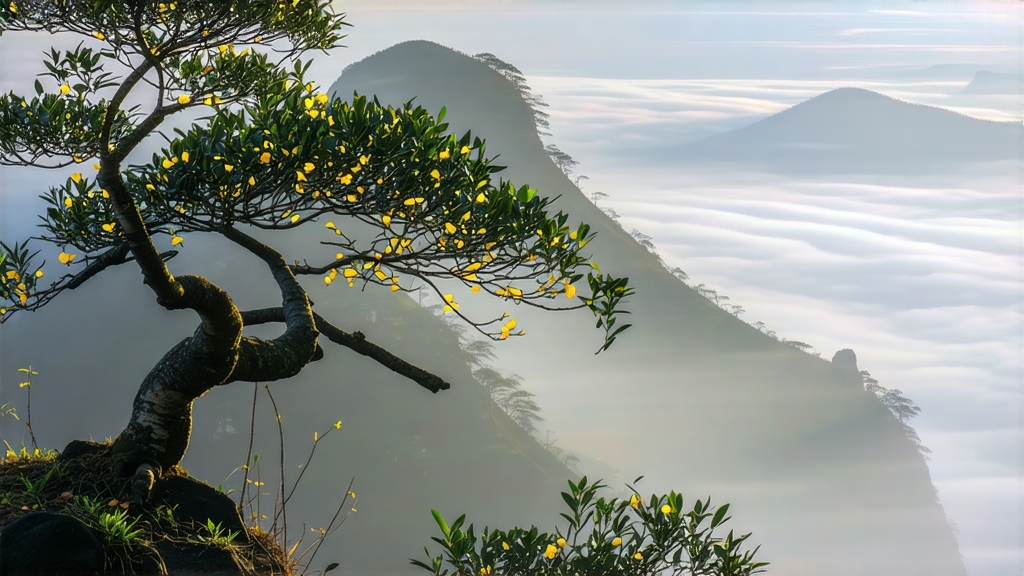
Tucked high on the northern rim of the Sichuan Basin, where the Min River cuts a gorge through 3,000-metre peaks, Meng Ding Mountain has been sending clouds skyward since the Tang dynasty. Those clouds act like a slow-motion waterfall, bathing the terraced gardens in moisture and diffusing sunlight into a soft, yellow glow. It is here, between 800 and 1,400 m above sea level, that Meng Ding Huang Ya—literally “Mengding Yellow Bud”—has been quietly perfected for twelve centuries, earning the nickname “the tea that emperors drank before they knew champagne.”
Historical whispers
The first written record appears in 808 CE, when the monk Gan Lu (“Sweet Dew”) presented a batch of early-spring buds to the Tang court. By the Song dynasty the tea had become an imperial tithe; each Qingming festival, before the grain rain, 360 Buddhist monks climbed the mountain to pick exactly 36,000 buds—one for every day of the lunar year. The last emperor, Puyi, still received a 200-gram tin in 1908, wrapped in yellow silk embroidered with five-clawed dragons. When the empire collapsed, the recipe almost vanished; only three families in the village of Shangqing continued the yellowing process. Rediscovered during the 1954 national tea survey, Meng Ding Huang Ya was re-established as one of China’s ten famous teas, yet it remains the least exported, accounting for less than 0.02 % of China’s annual tea trade—rarer even than panda-grade da hong pao.
Micro-ecology and cultivar
The mountain’s classic terroir is a sandwich of Devonian sandstone and purple shale, rich in potassium and selenium. Morning fog lowers the ultraviolet index, forcing the tea bush (Camellia sinensis var. sinensis, local clone “Mengding #9”) to synthesize more theanine and less catechin. The result is a leaf that is already sweet before it ever sees a wok. Buds are picked when they are still closed “like a sparrow’s tongue,” 15–20 mm long, containing 70 % moisture and a downy trichome that will later give the liquor its shimmering “golden down” suspension.
Craft: the art of “men huang”
Yellow tea’s identity rests on a unique microbiological step called men huang—literally “sealed yellowing.” After the familiar kill-green (sha qing) at 160 °C on a bronze wok, the leaf retains 45 % moisture. Instead of rolling immediately, the warm leaf is piled in bamboo trays, covered with wet linen, and left to breathe in a 28 °C, 75 % RH room. Over 48–72 hours non-pathogenic yeasts (Candida parapsilopsis, Pichia fermentans) oxidize chlorophyll into pheophytin, turning the leaf jade-yellow while converting bitter catechins into softer theaflavins. The pile is turned every three hours to prevent anaerobic decay; the master judges readiness by aroma alone—when the green grass note surrenders to chestnut and dried apricot, yellowing is complete. A light rolling follows, then slow charcoal drying at 45 °C for eight hours. The finished tea contains 7 % moisture, looks mustard-yellow with ivory tips, and smells like warm wheat bread.
Grades and nomenclature
Modern commerce recognizes three grades:
• Ming-qian Imperial (picked Qingming festival, 6,000 buds/500 g)
• Yu-qian Grade A (picked Grain Rain, 9,000 buds/500 g)
• Spring Select (picked to Beginning of Summer, 15,000 buds/500 g)
Only the Imperial grade undergoes the full 72-hour men huang; lesser grades are shortened to 36 hours, producing a greener, more astringent cup.
Water philosophy
Sichuan tea masters insist on “living water,” preferably snowmelt from the mountain’s 86 springs. For international brewers, the closest proxy is low-TDS spring water at 8–12 °F hardness. Tap water stripped with activated carbon works, but never distilled—minerals act as electron donors, brightening the yellow pigments.
Brewing gongfu style
- Warm the gaiwan with 85 °C water; discard.
- Use 3 g leaf per 100 ml vessel; the buds are fluffy, so level the surface without compression.
- First steep: